How Scientifically Accurate Are The Spores On The Last Of Us?
Thanks to two video games and a television adaptation, "The Last of Us" has managed to make us far more wary of the noble mushroom than we used to be. Well, more specifically, the cordyceps mushroom that brings about the end of the world and turns humanity into various forms of infected that look like raging, roaring fungi. But just how much of the homegrown danger in HBO's beloved post-apocalyptic series holds true? Will the world crumble under such a ferocious fungus? Well, like a lot of horrifying infections from film and television that have some fact in their blood, the infection in HBO's show is real and survives by doing precisely what we see in "The Last of Us," albeit with smaller organisms.
Ophiocordyceps unilateralis (via Yale University) is a type of fungus that infects the brains of ants and spreads through the host, taking control of their muscles and directing them to perform its bidding. With the fungus in control, the ant will climb to the highest and most advantageous location for the fungus to thrive and expand, eventually overgrowing the ant's entire body until only a husk remains. That harrowing idea has been brought to life in "The Last of Us," where we've been given occasional glimpses of victims of the cordyceps embedded in walls, lost to the entity that has overtaken them. While it might seem like a chilling concept to contemplate, there has been one human case that was brought to light during the airing of "The Last of Us" season 1.
A fungus infected a researcher during the airing of The Last of Us season 1
Just as "The Last of Us" was gaining a whole new wave of fans with the HBO adaptation, news emerged regarding a medical case that understandably unnerved anyone who had been paying attention to how the cordyceps worked on the show. According to The Telegraph, a plant mycologist from Kolkata, India, in 2023, ended up in the hospital following the first reported case of a human being infected by a fungal disease that usually infects plants.
While there were no details that lined up with the symptoms and after effects displayed in the bleak universe of "The Last of Us," the mycologist suffered from a cough, fatigue, and difficulty swallowing for three months, as well as developing an abscess on his neck after coming in contact with Chondrostereum purpureum, which is a fungus that causes the silver leaf disease in plants, and most frequently roses.
Thankfully, the patient made a full recovery after receiving treatment for two months, and no other cases have been confirmed since this rare but equally unsettling case. However, while this issue was swiftly remedied, it hasn't stopped other cases of infections happening with different fungi. Millions of variations exist, with a handful capable of inhabiting and surviving within the human body. What's perhaps even more alarming is that we're reaching a point where they're beginning to evolve and could become a greater threat than they already are.
Millions of people are affected by fungus each year, but thankfully, no cordyceps
While the Kolkata case might have been a rarity of a fungus that usually infects plants and occasionally infects humans, there are cases where other fungi can cause issues, leading to infections in humans, which isn't new. Per the CDC, there are millions of fungi in the world, but only a few hundred that can make people sick. This is often caused, like so many other diseases, because of a poor immune system. These illnesses can include aspergillosis, blastomycosis, and candidiasis.
As for cordyceps, though, we can be safe in the knowledge that there won't be a risk of humans getting infected and yet another television show giving us a terrible prediction of what's to come. According to Scott Roberts, MD, assistant professor of medicine at Yale School of Medicine and associate medical director for infection prevention at Yale New Haven Hospital, "There are millions of different fungal and mold species out in nature that don't cause any sort of infection in humans, and this is one of them. A Cordyceps that infects one species of ant cannot even infect other species of ants." With that in mind, scary mushrooms of that nature aren't anything to worry about. Kaitlyn Dever's Abby coming at us with a golf club, however, is something else entirely.


